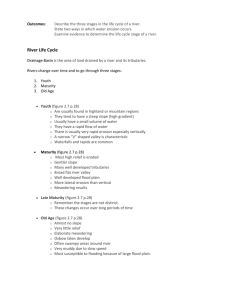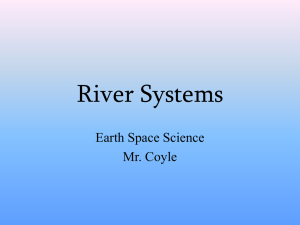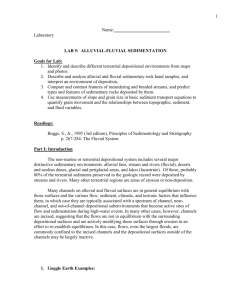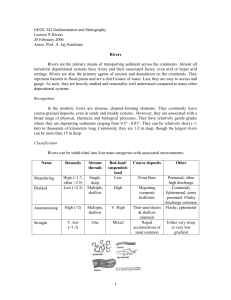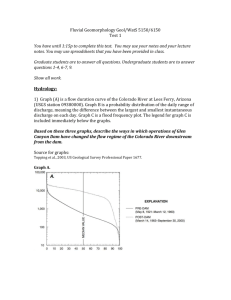PART IV: CHANNEL PATTERNS
advertisement
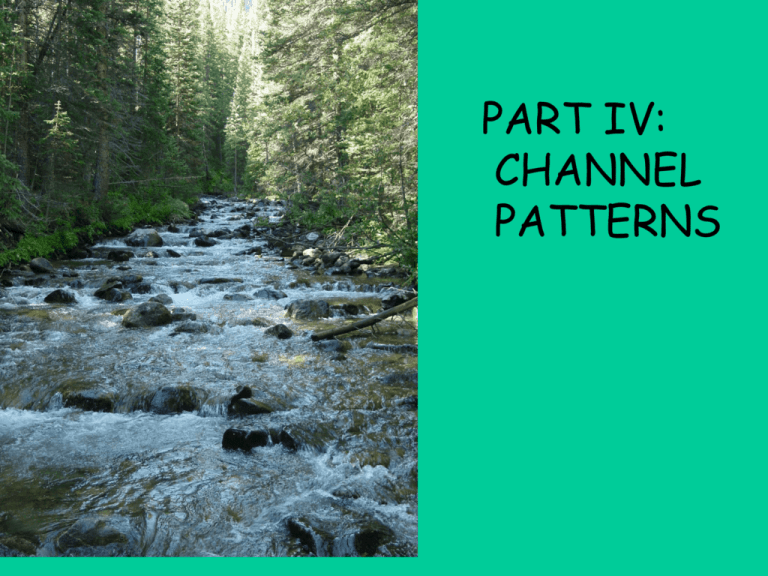
PART IV: CHANNEL PATTERNS Channel Classification Systems 1) sequence with respect to structure consequent subsequent obsequent 2) sequence with respect to time antecedent superimposed 3) plan-view shapes of drainage system dendritic complex parallel compound 4) Davis’ Cycle of Erosion youthful 5) flow duration mature rectangular old ephemeral perennial intermittent seasonal bed-load mixed-load suspended-load eroding stable depositing 6) Schumm’s % silt-clay (M) in channel boundary 7) regime Knighton 8) boundary resistance cohesive 9) planform regularity braided anastomosing non-cohesive meandering 10) number of flow paths in a reach single channel multi-channel 11) Montgomery & Buffington’s bedforms cascade pool-riffle step-pool dune-ripple (regime) straight compound plane bed 12) Rosgen multiple types There is no generally accepted classification system, and any individual channel can be described by several different names, depending on the classification system used. Montgomery & Buffington, 1997 step-pool cascade pool-riffle plane bed Rosgen (Rosgen, 1994) gradient bed material width/depth ratio sinuosity lateral constraint The form of multiple channels is partly stage-dependent. 1) braided – multiple flow paths within a single channel 2) anastomosing/anabranching – multiple channels Braided? Anastomosing? rivers on Alaskan coastal plain The most commonly used classification is that of straight, meandering, and braided, interpreted through a continuum – channel pattern is controlled by interactions among a set of continuous variables, so all channel patterns intergrade The three basic types of patterns can be related to each other by variations in stream power, sediment load, boundary composition or stability, or slope-discharge Progression from straight to meandering to braided corresponds to i) increasing width-depth ratio decreasing bank stability increasing bedload ii) increasing stream power – which means increasing Q at constant slope, or increasing slope at constant Q iii) increasing sediment load, particularly bedload Appears to be rapid change at thresholds straight meandering braided anastomosing * 0.05 BRAIDED 0.01 0.005 * * 0.001 0.0005 0.0001 0.00005 s = 0.012 Q-0.44 ** * MEANDERING 5 50 10 100 * * * 500 1,000 + * 5000 50,000 10,000 100,000 landform instability BANKFULL DISCHARGE (m3/s) braided island braided multichannel straight 10-1 meandering s = Fd/w braided - 10-2 single channel (straight) + - 10-3 braided transition meandering 10-4 - 10-5 10-4 10-3 10-2 transition straight 10-1 (Width:Depth Ratio)-1 (d/w) 100 single channel (meandering) hydrogeomorphic disturbance catastrophic change (bifurcation) 0.1 + CONTROLS ON CHANNEL ADJUSTMENT Dominant controls on channel form adjustment are discharge of water & sediment independent variables integrating effects of climate, vegetation, soils, geology, & basin physiography Because of the complexity & multiple feedbacks involved, one of the first & most important steps is to choose a suitable timescale on which to study the physical relationship of interest Important to define time span of interest because the relationships between the variables change with time (e.g., valley slope) TIMESCALES instantaneous or steady time (< 10-1 years) short time scale (101 – 102 years) graded time – medium time scale these are the most 3 4 (10 – 10 years) relevant for channel long or cyclic time form adjustment 5 (> 10 years) Schumm & Lichty (1965): time, space and causality the distinction between cause & effect in landform development is a function of time & space (area) because the determining factor can be either a dependent or an independent variable during a long time period, a drainage basin may be an open system progressively losing energy & mass (as envisioned in Davis’ erosion cycle), whereas over shorter timespans, self-regulation is important, & the basin may be graded, or in dynamic or steady-state equilibrium these concepts are not mutually exclusive Adjustments to the internal geometry of the fluvial system involve the variables of flow properties & sediment properties, including channel form Distinguish between 1) channel geometry: the 3d form of the channel over longer time periods responding to the dominant discharges of water and sediment 2) flow geometry: interactions among variables during temporal changes in discharge, emphasizing crosssectional and reach scales A stream must satisfy three physical relations in adjusting flow geometry 1) continuity 2) flow resistance Q=wdv e.g., Manning: v = 1.49 R0.67 S0.5 n 3) a sediment transport equation HYDRAULIC GEOMETRY developed by Leopold and Maddock (1953) assumes that water discharge is dominant independent variable, & that dependent variables are related to Q in the form of simple power functions v = k Qm S = g Qz w = a Qb d = c Qf Q = w d v = a Qb c Qf k Qm ack=1 b+f+m=1 technique is applicable to at-a-station & downstream adjustment neglects sediment transport assumption of linearity is not quite adequate, but this represents a way to break into a system with more unknowns than independent equations There have been attempts to quantify the equilibrium cross section on the basis of cross-sectional parameters (regime theory), & to explain downstream variations in the channel downstream hydraulic geometry: treats spatial variations in channel properties at a reference discharge at-a-station hydraulic geometry: deals with temporary variations in flow variables as discharge fluctuates at a cross section Maddock (1970) impossible to establish determinate relations for the solution of the dual problems of resistance to flow & sediment transport in alluvial channels the best we can is to predict general patterns of stream behavior Graf (2001): the probabilistic river (probable patterns of behavior) Channel geometry: 3d entity; adjustment to external controls can be considered in terms of four degrees of freedom cross-sectional form bed configuration planimetric geometry or channel pattern channel bed slope original Lane’s balance expanded Lane’s balance 105 climate, tectonics 104 profile gradient Increasing length scale, m land use, river engineering profile concavity 103 reach gradient 102 meander wavelength bed configuration: gravel-bed streams 101 channel width 100 bed configuration: sand-bed streams 10-1 10-1 channel depth profile form plan form cross-sectional form 100 101 102 Increasing time scale, years 103 104 Boulder knickpoint Bedrock knickpoint Sand bedforms downstream variations f (Q, Qs) e.g., flashy regime + high peak flows = wider channels coarser load = wider, shallower channels channel size may be adjusted to Qs, and channel shape to the type of load (thus Schumm’s M classification) in general, dominant controls on cross-sectional form are discharge absolute & relative amounts of bedload transport composition of channel boundary/bank stability multivariate character of these controls implies that the approach of downstream hydraulic geometry can only indicate trends – equilibrium (underlying downstream trends are random & systematic local fluctuations in xs form such as pools & riffles) Equilibrium Dictionary: Equilibrium exists in any system when the phases of the system do not undergo any change of properties with the passage of time, and provided that the phases have the same properties when the same conditions, with respect to the variants, are again reached by a different procedure. The first part of this definition is most applicable to fluvial geomorphology. Idea of equilibrium first introduced to geomorphology by Gilbert (1877), then modified by Mackin (1948), Leopold & Maddock (1953), and Wolman (1955) There is no exact equilibrium, but rivers tend to develop an average behavior Descriptions of fluvial geomorphic equilibrium concentrate on adjustments to cross-sectional form & channel pattern, rather than on channel profiles Equilibrium also implies feedback mechanisms & thresholds Types of Equilibrium static increasing time State of System steady state dynamic Time dynamic metastable Another way to express the ideas embodied in equilibrium uses a method analogous to thermodynamics & entropy – this defines a most probable state, which is a balance between the uniform distribution of energy expenditure & minimum total work: minimum variance Both minimum variance & equilibrium are controversial --no universally-accepted set of criteria for determining equilibrium importance of transient fluctuations vs long-term trends depends on timescale of interest persistence & characteristic form times differ between rivers & between components of a river Minimum Variance Theory 1) minimize variance of selected variables at different sections along a reach, and 2) minimize the sum of the squares of the exponents in the hydraulic geometry relations Theory proposed by Leopold & Langbein when they stated that streams exhibit opposing tendencies which must be balanced – tendency toward equal energy expenditure (constant stream power per unit area of bed) and tendency toward minimization of energy expenditure over length of river L (total power, ∫ Ω dx 0 minimum) Undulating wall example Wohl et al., 1999 Extremal Hypotheses Langbein & Leopold (1964): balance minimum total rate of work vs uniform distribution of energy expenditure Yang (1971): minimum energy dissipation rate Davies & Sutherland (1980): maximum friction factor Grant (1997): maintenance of critical flow in steep channels Eaton et al. (2004): greatest relative stability achieved by maximizing resistance to flow in the fluvial system Nanson & Huang (2008): least action principle of how rivers adjust toward conditions that minimize change & maximize operational efficiency Lag times – response of physical systems tends to lag behind changes in process intensity Different components have different lag times, depending on 1) resistance to change by various morphologic components & the system as a whole (e.g., bedrock is more resistant than a sand bed) 2) complexity of the system – the number of components involved and the character of their interactions 3) magnitude & direction of the input change, which reinforces or conflicts with existing tendencies 4) energy environment of the input (e.g., headwaters are more responsive than the mouth) Transient form ratio for persistence TF = mean relaxation time mean recurrence time TF > 1, forms transient TF < 1, forms persist character Threshold-equilibrium plot T agg. E altitude of floodplain, as modeled by Bull deg. E time Conceptual models encourage studies of changes & of self-enhancing feedback – easy to note passing of threshold, but difficult to exactly predict threshold because difficult to quantify driving & resisting forces power of paradigms Dominant discharge: can be defined as the flow which determines channel parameters (geomorphic effectiveness), or the flow which transports the most sediment (geomorphic work) geomorphic effectiveness (persistence of features relative to recurrence interval of flow) geomorphic work (sediment transport) EW EW grad student What type of flow “controls” a river? Varies for different climatic & topographic environments, & because of uncertainty as to what constitutes control Sediment transport rate Frequency of occurrence Product of magnitude + frequency Dominant discharge defined in terms of magnitude and frequency of sediment transport by a given range of discharges (Wolman and Miller, 1960) Discharge Qd Originally, dominant discharge was equated with a bankfull discharge of 1-2 year recurrence interval on humid temperate streams This approach is limited because bankfull channel can’t always be defined in field Qb is not of constant frequency channel form parameters don’t necessarily correlate best with Qb Qb may not be the most effective flow for sediment transport whole idea doesn’t work well for highly variable flow regimes found outside humid temperate regions, such as deserts or seasonal tropics [problems with respect to channel restoration] Channel form is not the product of a single formative discharge, but of a range of discharges & of the temporal sequence of flows instream flow (e.g., Boulder Creek, 400 vs 50 m3/s; O’Connor et al., 1986) channel maintenance flow role of floods (e.g., Grand Canyon rapids; Kieffer, 1985, 1989) Streams affected by floods have flashy hydrographs produced by high relief high drainage density equant basin shape high frequency of first order streams high basin magnitude sparse vegetation thin soils Also characterized by high channel gradients abundant coarse bedload relatively low bank cohesion channel cross sections which enable flood discharges to be accompanied by deep, high velocity flows where macroturbulent flow phenomena exist Kochel, 1988 Big Thompson River, Colorado 1976 flood Patton (1988): Drainages in southern New England for drainages in the highlands, sedimentation during floods is an important process in constructing fluvial landforms such as floodplains erosion & deposition are localized, vegetation can mask the flood effects, & moderate flows can re-work the floodcreated landforms, but periods of stasis & soil formation are interrupted abruptly by major floods that add much sediment to the floodplain surfaces (14C) in lowland drainages, in contrast, flood deposits tend to be completely reworked by moderate flows (original study in 1960) Persistence vs recurrence the persistence of landforms vs the recurrence interval of a given discharge value Regression models expressing some channel parameter as a function of some discharge only apply to regime or steady-state rivers – cannot describe a mean behavior where large discharge fluctuations occur Burdekin & Herbert rivers and Nepal GLOFs as examples (Wohl, 1992a, b Cenderelli & Wohl, 2001, 2003) Herbert River, Australia Bhote Kosi 1985 GLOF Cenderelli, 1998 BED CONFIGURATION Bedforms means of adjustment in vertical dimension (related to horizontal adjustments) effect of instability at water-sediment interface indicate systematic tendencies in the ability of natural systems to sort & transport material over a wide range of flow & bed material conditions Bedforms geometry depends on prevailing flow, sediment discharge, & bed material properties represent both response to changing discharge & load conditions, & means of regulating, through resistance, hydraulic variables exert a drag on the flow additional to that of the grains – bedform adjustment represents both a response to changing discharge & load conditions, and a means of regulating, through resistance, hydraulic variables such as velocity & depth Pool and riffle sequence alternating deeps & shallows occur in straight and meandering channels successive pools spaced approx. 5-7 X channel width riffles: wider, shallower at all stages of flow coarser materials steeper water-surface at low flow deposition at high flow (velocity reversal?) Thompson et al., 1996, 1998, 1999 North St. Vrain Creek, CO n CA North Fork Poudre River, CO Knighton Explanations for the occurrence of pools & riffles include kinematic waves dispersion & sorting convergence & divergence of flow macroeddies in turbulent flow essentially, a pool & riffle sequence is a means of selfadjustment in streams – it is important in the attainment & maintenance of quasi-equilibrium, and for the development of meandering pools & riffles and meandering are two sources of flow resistance capable of modifying the rate & distribution of energy loss at the reach scale • velocity-reversal hypothesis(Keller, 1971) remains difficult to demonstrate, but formation of a central jet in pools (Thompson et al., 1998, 1999) likely to be important Figure S4.12 eddy jet vortex recirculating eddy pool length jet shear zone main flow Keller & Melhorn (1978): Rhythmic spacing and origin of pools and riffles pools & riffles = meandering in the 3rd (vertical) dimension fundamental characteristic of many streams, independent of substrate type 70% of variability of spacing of pools can be explained by variability of channel width Roy & Abrahams (1980), commenting on Keller & Melhorn separated bedrock & alluvial rivers from the K&M dataset, found that mean pool spacing of bedrock streams is greater could be because bedrock channel forms are adjusted to discharges of higher magnitude & lower frequency, or because spacing is related to sediment size in transport Lisle (1986) large obstructions (bedrock outcrops, instream wood, rooted bank projections) & bedrock bends stabilize the location & form of gravel bars large obstructions and bends cause intense secondary circulation in scour holes that terminate upstream bars at fixed locations bars are deposited upstream from large obstructions due to backwater reductions in stream power; they are deposited downstream because flow energy is expended around obstructions, & flow expands upstream 85% of pools are next to large obstructions or bends Lisle (1982) studied effects of Dec. 1964 flood on 12 rivers in n CA hydraulic changes with aggradation indicate an increase in the effectiveness of moderate discharges (1-2 year recurrence interval) to transport bed load & shape the bed bars become smaller, pools preferentially fill, & riffles armored with relatively small gravel erode headward during the falling stages & form a gentler gradient excess sediment can thus be more readily transported out of channels degraded reaches show higher percentage length of channel as pools, & lower percentage as runs than do aggraded reaches step-pool channels alternating vertical steps (clasts, wood, bedrock) and plunge pools (Chin & Wohl, 2005; Church & Zimmermann, 2007) S > 0.02 1 < H/L/S < 2 (Abrahams et al., 1995) anti-dune hypothesis (Whittaker & Jaeggi, 1982) jammed state hypothesis (Zimmermann & Church, 2001) Estimated recurrence interval for step formation varies from annual in Japan (Sawada et al., 1983) to 30-50 years in Italy (Lenzi, 2001) to > 50 years in US Cascades (Grant et al., 1990) nappe vs skimming flow dramatic decrease in flow resistance & increase in velocity (Comiti et al., 2009) • bedload transport is extremely spatially & temporally variable • Yager et al. (2007) proposed a modified version of the Parker (1990) bedload equation to include the resistance associated with steps & selective transport of relatively mobile sediment using a range of hiding functions qsm* = 5.7 (τm* - τcm*)1.5 (Am/At) qsm* τm* τcm* Am At dimensionless transport rate of mobile sediment dimensionless stress borne by the mobile sediment dimensionless critical shear stress of the mobile sediment bed-parallel area of mobile sediment total bed area • particles in pools are preferentially entrained & transported longer distances • step-pool channel segments are transport reaches that are less sensitive to changes in water & sediment discharge (Montgomery & Buffington, 1997; Ryan, 1997; Wohl & Dust, 2012) pool-riffle sites with augmented flow 1.80 1.60 Corral 1 Corral 2 Corral 3 Bankfull depth (m) 1.40 Hague 1 Hague 2 1.20 Hague 3 1.00 La Poudre Pass 1 La Poudre Pass 2 0.80 La Poudre Pass 3 0.60 La Poudre Pass 4 0.40 La Poudre Pass 5 step-pool sites with augmented flow 0.20 0.00 0 10 20 30 40 50 A (km 2) 60 70 80 Poudre 1 Poudre 2 Poudre 3 90 100 “THE GREAT GRAND CANYON DEBATE” Leopold (1969): occurrence of rapids & pools represents a state of quasi-equilibrium, independent of bedrock type & valley characteristics Dolan et al. (1978): pools & rapids in the Canyon are located where the river crosses regional & local fracture zones Graf (1979): Colorado Plateau rivers – spacing of rapids in canyon rivers is random, & local-site conditions are more significant than canyon-long operations of the main river system Webb et al. (1988): large boulders transported into the Colorado River by debris flows along tributary canyons create or change hydraulic controls (rapids) – controls are governed by the magnitude-frequency of tributary flows, & by history of discharges on Colorado River Channel Form Adjustment occurs in the horizontal plane influences resistance to flow, & is an alternative to slope adjustment when slope is constant on short & medium time scales compound meandering bank resistance braided sinuosity or d/w stream power A catastrophe theory representation of the interaction of the controlling variables stream power & channel slope with a responding variable, channel configuration as measured by sinuosity Compound channels occur in the folded portion of the diagram where two possible states exist for given combinations of power & slope (Graf, 1979a, 1988b) Compound Channels e.g., series of low gradient, anastomosing, savanna streams in Australia – two theories 1) Rust (1981): the sand underlying the clays indicates a former braided system 2) Nanson et al. (1986): the clay-bed anastomosing streams are a modern phenomenon in which the clays dry out, aggregate, & are transported as bedload by high flow, braided rivers until they dissolve & are transported by low flow, anastomosing rivers (deeper, with lower w/d ratios) rip-up clast, Buckskin Gulch, AZ e.g., Graf (1988a) noted that arid region rivers frequently accomplish radical adjustments to extreme events by complete changes of channel configuration – paths are 1) gradual infilling during sustained periods of low flows, causing a change from braided to meandering configurations, & 2) rapid erosion during rare floods causing a change from meandering to braided these changes present problems in defining the floodplain for land-use zoning e.g., Fahnestock (1963) White River of Mt. Rainier, WA – glacial stream marked change from meandering to braided occurred with onset of high summer flows, & pattern returned to meanders with the low flows of autumn Fahnestock concluded that both braided & meandering stretches can occur along the same stream, which may be aggrading, stable, or degrading – pattern alone does not conclusively define the regime of the stream no slope change between meandering & braided – braiding occurred because of coarse load, which when deposited caused diversion to other channels rate of pattern change is related to amount of bedload e.g., Gupta and Dutt (1989), Auranga River, India seasonal tropics during low flows of dry season, active channel is a relatively narrow braided reach flanked by exposed point bars &, above and beyond, flood bars point bars are covered by bankfull wet season flows, when the river assumes a meandering form flood bars are covered by episodic large floods MEANDERS river on Alaskan coastal plain Yukon River in Alaska Wind River Range, WY Chena, Alaska – meandering & permafrost North Park, CO Wood River, Alaska the interrelation of channel width, radius, & wavelength of meanders is only one of several shape characteristics that show a tendency toward energy conservation meanders tend to approximate a sine-generated curve θ = ω sin S/M 2 ∏ θ = angle between the direction measured at a given point along the curve & the mean downstream direction ω = maximum value of θ S = distance along the path M = total path distance in a unit wavelength sine-generated curve represents the most uniform distribution of change along the curve – minimization of the sum of the turning angles will tend to minimize the total work of erosion on the bank this minimization is in opposition to the uniformity represented by equal angles of deflection, provided the curve were in the form of a circle – minimized variance (least work) is approached at the cost of less uniformity Leopold, 1994, A View of the River Leopold, 1994, A View of the River Meandering rivers in Alaska Yukon River Leopold, 1994, A View of the River San Juan Goosenecks, UT Paria River, UT Natural Bridges National Monument, UT meanders incised into bedrock Why meander? 1) flow properties flumes show that helicoidal flow & secondary currents create meanders flow pattern through meander bends involves superelevation of water against the outer bank, with a secondary transverse cell toward the outer bank at the surface & the inner bank at the bed OUTER high high * * low * * low low * * high INNER BANK REGION MID-CHANNEL BANK REGION REGION Super-elevated water surface Outward shoaling flow across point bar path lines of secondary flow * relative water surface elevation break in bed slope maximum velocity is toward the inner bank in the upstream limb of the bend, & then below the surface around the curve – so there is erosion at the outside of the bend & deposition on the inside explanations of meanders focusing on flow properties regard helicoidal flow & secondary currents as inherent properties of turbulent flow, which are manifested in meanders as deformable boundaries permit observation of the underlying wave-like structure in flows near-surface velocity near-bed velocity bar exposed at low flow thalweg break in bed slope 2) mechanics of sediment transport secondary flow is the result, rather than the cause, of meandering mobile bed of a channel with stable banks is unstable – instability occurs as alternating bars which grow in amplitude & form meanders – in this views, sediment transport is the essential factor other explanations include Chang’s minimization of stream power, but meanders are not necessarily the outcome of a single cause meandering is mainly a means of slope reduction for given external constraints Mattole River, n CA meander belt, Missouri River near St. Louis meandering channel scar, Rocky Mountain N.P. meanders North Park, Colorado rivers on Alaskan coastal plain Braided rivers high width-depth ratios steep slopes large bedloads rapid shifts in channel position at high discharge geometrical properties of braided rivers not as well studied as those of meandering rivers, partly because degree of braiding changes with discharge (bars covered at high stages) similarly, a characteristic sedimentary sequence equivalent to the fining-upward sequence of meander point bars has not been defined for braided rivers, partly because of the high sedimentary variability braided rivers occur in a range of climates, from proglacial to arid, & at a range of scales central AZ Arid-region braided rivers 1969 flood boulder train, Jordan River Death Valley, CA coastal Peru Glacial braided rivers Annapurna region, Nepal Jasper National Park, British Columbia Matanuska River, Alaska northeastern Brooks Range, Alaska initiation of braiding involves longitudinal bars, followed by transverse & point bars, & islands braiding, like meandering, is interpreted as a mode of adjustment to modify the stream’s energy use braided rivers are the default river morphology Yukon River, central Alaska anabranching meandering Platte River, Nebraska Probabilistic River Summary of methods used to convert air photos to a locational probability map (Graf, 2000, Figure 5) Examples of locational probability maps for Salt River near Phoenix based on 1935-1996 data (Graf, 2000, Figure 9) anastomosing – low sinuosity channels that split & rejoin anabranching – high sinuosity channels that split & rejoin reticulate – finer scale channels that split & rejoin Glacial braided rivers Annapurna region, Nepal Jasper National Park, British Columbia Matanuska River, Alaska Aggradation above tributary junction, Khumbu, Nepal upper Amazon basin, Ecuador Mt. St. Helens area, WA, 1997 braided rivers on coastal plain near Kotzebue, Alaska Biotic Influences on Channel Form Riparian vegetation roots increase soil cohesion by increasing shear strength of soil via root reinforcement decreases bank stability when weight of vegetation increases driving forces acting in downslope direction above-ground portion of vegetation intercepts precipitation & decreases infiltration that can decrease bank strength, as well as removing water from root zone above-ground portion increases hydraulic roughness on banks & floodplains & facilitates sediment deposition Rio Puerco, NM: moderate to densely vegetated banks = 40% reduction in perimeter-averaged shear stress and 20% reduction in shear stress in channel center (Griffin et al., 2005) riparian vegetation can cause a braided channel to self-organize to, & maintain, a single-thread channel (Tal & Paola, 2010) Riparian vegetation bank erosion can isolate rootmass of tree, creating scalloped bank that alters near-bank hydraulics & habitat (Rutherfurd and Grove, 2004) Riparian vegetation spatial changes in vegetation can alter downstream hydraulic geometry relationships (Huang & Nanson, 1997) and channel type different types can influence stream response to augmented peaks flows associated with snow-making (David et al., 2009) Aquatic & riparian animals microbial biofilms & fine sediment macroinvertebrates & silk fish & nests or redds crayfish & clast displacement Beaver dams pond water accumulate sediment & organic matter enhance extent, frequency & duration of overbank flooding reduce bed & bank erosion (Pollock et al., 2007) increase habitat diversity & stability (Naiman et al., 1988) facilitate formation of multi-thread channels & floodplain wetlands (Westbrook et al., 2006) Channel gradient & longitudinal profile H = f (L) longitudinal profiles tend to be concave upward, although they are rarely smooth, & may contain evidence of past events in their irregularities at a constant cross-sectional shape, the controls on channel gradient are Qs, φs, and Q (inversely) generally, steep slopes reflect coarse sediment, a small drainage area, & a wide, shallow channel concavity is also affected; profiles are more concave where bed-material size decreases rapidly, & they don’t have much concavity if particle size is constant or increasing downstream increasing discharge also produces concavity, because an increase in discharge means that the same load can be transported over lower slopes The adjustment of slope to sediment load is expressed in the concept of the graded stream, as proposed by Mackin (1948): graded alluvial streams with a stable flow regime have slopes just sufficient to transport the load supplied, & have a smoothly concave profile increasing discharge & decreasing bed material size provide a general explanation of profile concavity, but the profile reflects adjustments to many variables whose interaction in different combinations leads to a wide variety of profile forms: another example of a system with more dependent than independent factors knickpoints, for example, may indicate lithologic controls, or they may show progressive upstream erosion due to baselevel drop or other tectonic changes Hack equilibrium landscape development: all aspects of the landscape are mutually adjusted so that they downwaste at the same rate stream gradient index allows comparison of slope between streams SL = ∆ H L/ ∆ L ∆ H = reach fall ∆ L = reach length L = distance from drainage divide influenced by climate tectonics relief stream regimen geomorphic history Example of application of stream gradient indices Merritts & Vincent (1989) examined a series of rivers along coastal northern California, in region of Mendocino Triple Junction, where 3 tectonic plates meet 25 basins spread over areas of low (< 1 m/ky) intermediate (1-3 m/ky) high (> 3 m/ky) rates of uplift using stream gradient index & a variety of other geomorphic indices, they found channel gradients to be the best indicator of tectonism in the landscape lower order tributaries best reflect tectonically-controlled differences because large streams are able to adjust to base level changes & maintain their profile form, whereas lower-order streams farther upstream accumulate the effects of net base-level fall & have the steepest profiles in the areas of highest uplift rates semi-log plots arithmetic plots low uplift intermediate uplift high uplift Other work Goldrick & Bishop (2007) main channel flow tributary knickpoint, Wulik River, sw Brooks Range, Alaska Knickpoints & hanging valleys Prediction of Shang, the channel gradient at which incision rate falls below the rate of base level fall & permanent hanging valleys form (Crosby et al., 2007): 1 1bc1 / 4 1 1 1 2 S t K ' A S hang 2 cos cos 3S t 1 3 3 27 S t 4 3 2 (depends on steady-state transport-limited gradient St, channel erodibility K, percent of eroded material transported as bedload ß, and drainage area A) Prediction of maximum drainage area at which a temporary hanging 1 valley can form: Atemp k w k q b I max 1bc K GA U initial (Uinitial is background rate of base level fall) Effect of Uplift & Subsidence on Channel Morphology subsidence uplift uplift subsidence Meandering channel Braided channel Zone A Aggradation Thalweg shift Submerged bars Degradation Single thalweg Aggradation Thalweg shift Multiple channels axis B C D Degradation Terrace fm. Single bars Aggradation Braided Aggradation Braided Degradation Single thalweg flooding Degradation Sinuosity increase Bank erosion Degradation Sinuosity increase Bank erosion After Schumm, Mosley & Weaver (1987) Aggradation Aggradation Local scour Flooding, cutoffs, multiple channels (Schumm et al., 2000) Channel evolution models Simon & Hupp (1986) Long debate on relative importance of external (land use, climate) versus internal triggers for channel incision


